AUDI Q5 2014 Owners Manual
Manufacturer: AUDI, Model Year: 2014, Model line: Q5, Model: AUDI Q5 2014Pages: 316, PDF Size: 78.41 MB
Page 271 of 316
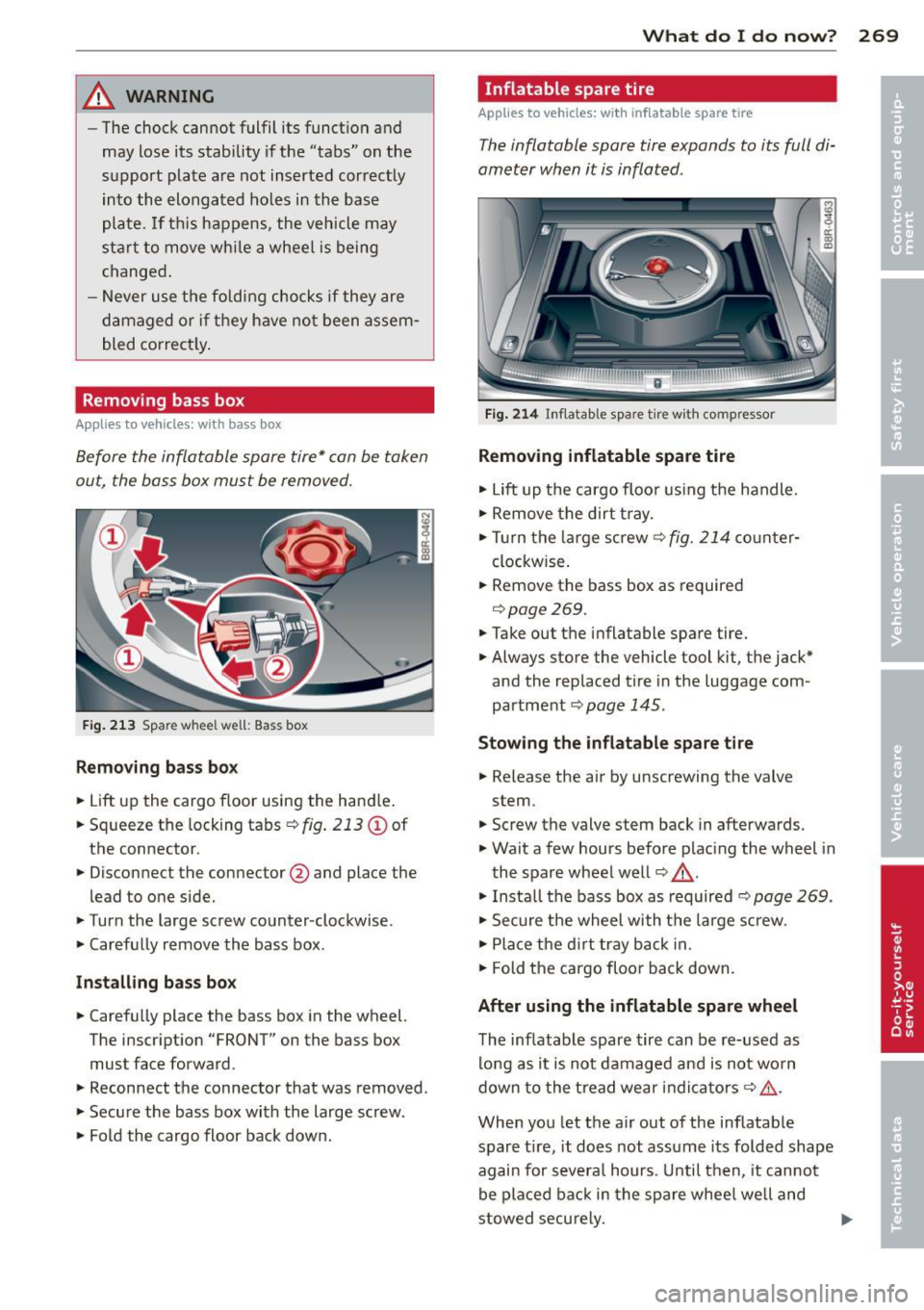
_& WARNING
-The chock cannot fulfil its funct ion and
may lose its stability if the "tabs" on the
support plate are not inserted cor rectly
into the elongated holes in the base
pla te. If th is happens, the vehicle may
st ar t to move whi le a wheel is being
changed .
- Never use the folding chocks if they are
damaged or i f th ey have not been assem
bled correct ly .
Removing bass box
Applies to vehicles: with bass box
Before the inflatable spare tire* can be taken
out, the bass box must
be removed.
Fig . 2 13 Spare w hee l well : Bas s box
Removing bas s bo x
.,. Lift up the cargo floor using the hand le .
.,. Sq ueeze the locking tabs
c:!;> fig . 213 (D of
the connector.
.,. Disconnect the connector @and place the
lead to one side.
.,. Turn the large screw counter -clockwise .
.,. Carefu lly remove the bass box .
Install ing bas s bo x
.,. Carefu lly place the bass box in the wheel.
The inscr ipt ion "FRONT" on the bass box
must face forward .
.,. Reconnect the connector that was removed .
.,. Secure the bass box with the large screw.
.,. Fold the cargo floor back down.
What do I d o now ? 269
Inflatable spare tire
Applies to vehicles: with inflatable spare tire
The inflatable spare tire expands to its full di
ameter when it is inflated.
Fi g. 21 4 In flatable spa re t ire w it h comp ressor
Removing inflatable spare tire
.,. Lift up the cargo floo r using t he handle .
.,. Remove the dirt t ray .
.,. Turn the large screw
c:!;> fig. 214 co unter
clockw ise .
.,. Remove the bass box as required
c:!;> page 269 .
.,. Take out the inflatable spare tire .
.,. Always store the vehicle tool kit, the jack*
and the replaced tire in the luggage com
partment
c:!;> page 145.
Stowing the inflatabl e spare t ire
.,. Release the air by unscrewing the valve
stem .
.,. Screw the valve stem back in afterwards .
.,. Wait a few hours befo re placing the wheel in
the spare wheel well
c:!;> .,&. .
"'Insta ll the bass box as required c:!;> page 269 .
.,. Secure the wheel with t he la rge screw .
.,. Place the d irt tr ay back in .
.,. Fold the cargo floor back down.
After using the inflatable spare wheel
T he inflatab le spare tire can be re-used as
l ong as it is not damaged and is not wo rn
down to the t read wea r indica tors
c:!;> ,& .
When you let the a ir out of the inflatab le
spare t ire , it does not assume its folded shape
again for s evera l hours . U nti l then , it canno t
be pla ced ba ck in the spare whee l we ll and
stowed secure ly.
Page 272 of 316
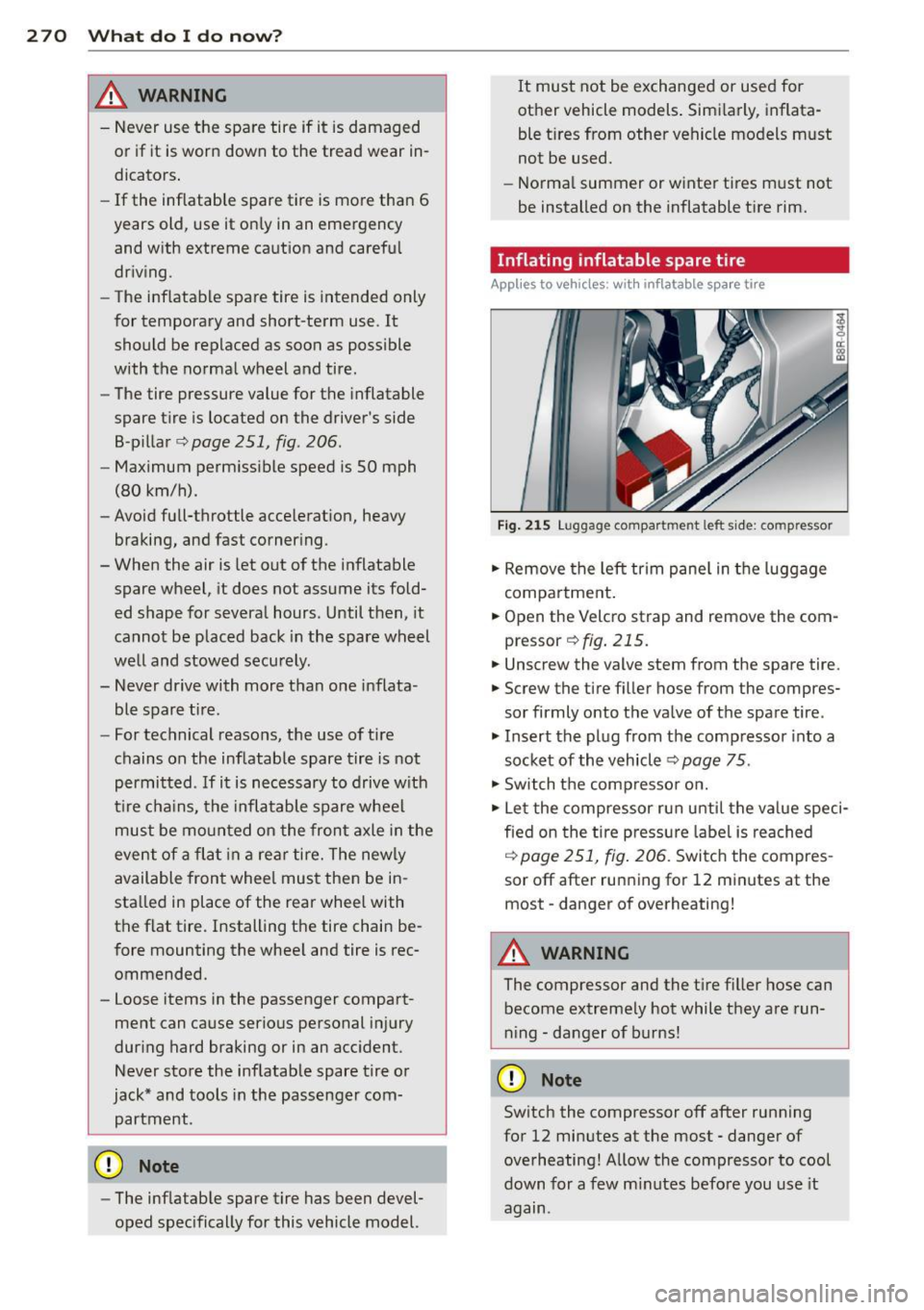
2 70 What do I do now?
A WARNING
-Never use the spare tire if it is damaged
or if it is worn down to the tread wear in
dicators.
- If the inflatable spare tire is more than 6
years old, use it only in an emergency
and with extreme caution and careful
driving.
- The inflatable spare tire is intended only
for temporary and short-term use. It
should be replaced as soon as possible
with the normal wheel and tire.
- The tire pressure value for the inflatable
spare tire is located on the driver's side
8-pillar
¢ page 251, fig. 206.
- Maximum permissible speed is SO mph
(80 km/h).
- Avoid full-throttle acceleration, heavy
braking, and fast cornering .
- When the air is let out of the inflatable
spare wheel, it does not assume its fold
ed shape for several hours. Until then, it
cannot be placed back in the spare wheel
well and stowed securely.
- Never drive with more than one inflata
ble spare tire.
- For technical reasons, the use of tire
chains on the inflatable spare tire is not
permitted .
If it is necessary to drive with
tire chains, the inflatable spare wheel
must be mounted on the front axle in the
event of a flat in a rear tire. The newly
available front wheel must then be in
stalled in place of the rear wheel with
the flat tire. Installing the tire chain be
fore mounting the wheel and tire is rec
ommended.
- Loose items in the passenger compart
ment can cause serious personal injury
during hard braking or in an accident.
Never store the inflatable spare tire or
jack* and tools in the passenger com
partment.
Q) Note
- The inflatable spare tire has been devel
oped specifically for this vehicle model.
It must not be exchanged or used for
other vehicle models. Similarly, inflata
ble tires from other vehicle models must
not be used.
- Normal summer or winter tires must not
be installed on the inflatable tire rim.
Inflating inflatable spare tire
Applies to vehicles : wit h in flatable spa re tire
Fig. 215 L u ggage compartment left side : compressor
.,. Remove the left trim panel in the luggage
compartment.
.,. Open the Velcro strap and remove the com
pressor ¢
fig. 215.
.,. Unscrew the valve stem from the spare tire.
.,. Screw the tire filler hose from the compres
sor firmly onto the valve of the spare tire .
.., Insert the plug from the compressor into a
socket of the vehicle
r=;, page 75 .
.., Switch the compressor on.
.., Let the compressor run until the value speci
fied on the tire pressure label is reached
r=;, page 251, fig. 206. Switch the compres
sor off after running for 12 minutes at the
most -danger of overheating!
A WARNING
= The compressor and the tire filler hose can
become extremely hot while they are run
ning -danger of burns!
(D Note
Switch the compressor off after running
for 12 minutes at the most -danger of
overheating! Allow the compressor to cool
down for a few minutes before you use it
again .
Page 273 of 316
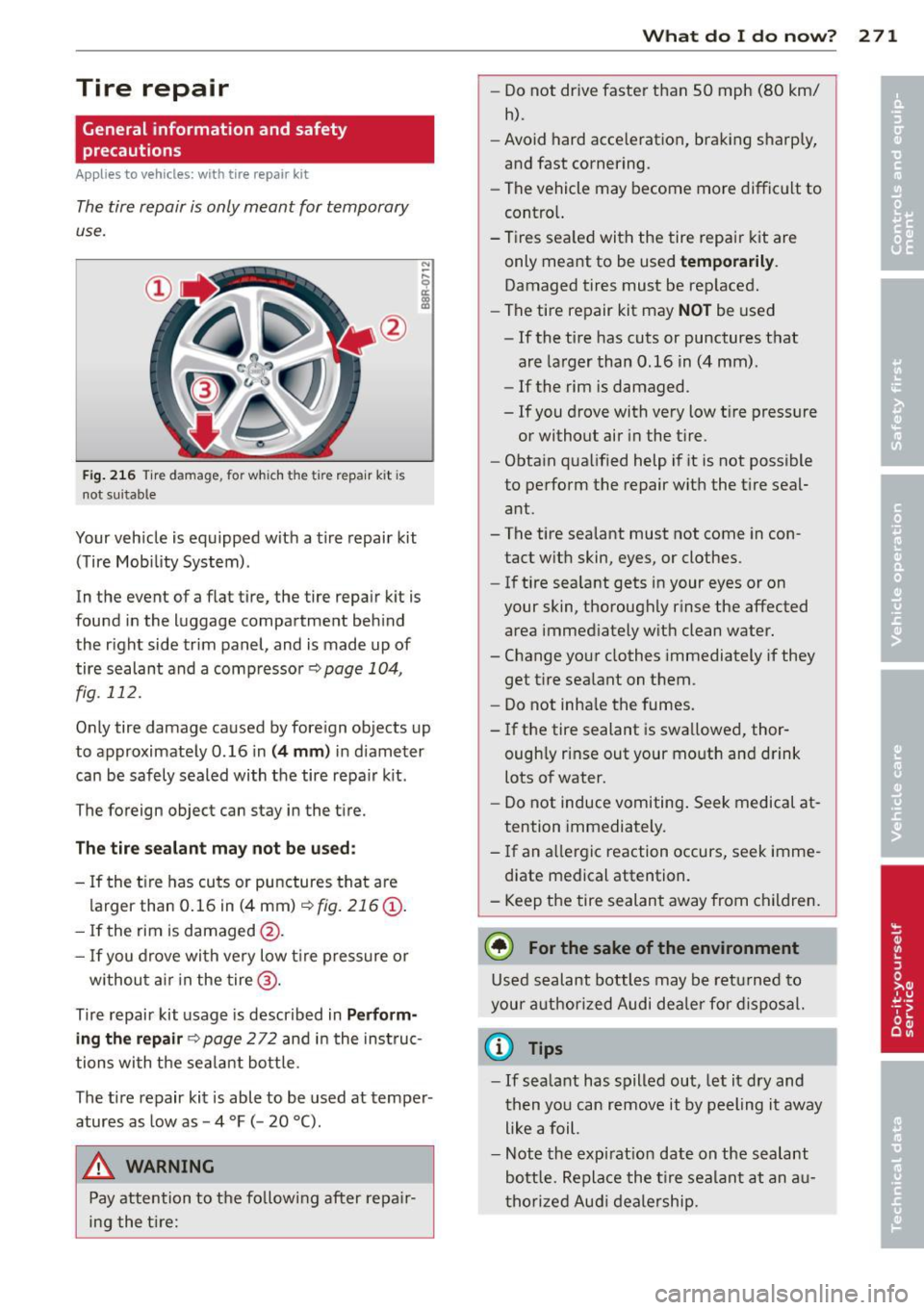
Tire repair
General information and safety
precautions
Appl ies to vehicles: with tire repair kit
The tire r epair is only m eant for tempo rary
use.
Fi g. 2 16 Tire damage, fo r which the tire repair kit is
not su itab le
Your veh icle is equipped with a tir e repair kit
(Tire Mob ility System) .
In the event of a flat tire, the tire repair kit is
found in the luggage compartment behind
the right side trim panel, and is made up of
tire sealant and a comp resso r
Q page 104,
fig. 112.
Only tire damage caused by fore ign objects up
to approximately 0.16 in
( 4 mm) in diameter
can be safely sealed with the tire repa ir k it .
The foreign object can stay in the t ire.
Th e tire sealant may not b e us ed :
- If the t ire has cuts or punctures that are
larger than 0 .16 in (4 mm)
Qfig. 216@.
-If the rim is damaged @.
-If you drove wi th very low t ire press ure o r
without a ir in the tire @.
Tire repair kit usage is descr ibed in
Perform
in g th e repair
Q page 2 72 and in the inst ruc
tions wi th the sea lant bottle.
The tire repair kit is able to be used at temper
atures as low as -4
°F ( -20 °().
A WARNING
Pay attention to t he fo llowing after repa ir
ing the t ire:
What do I d o now ? 271
-Do not dr ive faster than SO mph (80 km/
h).
- Avoid hard acce leration, braking s harply,
and fast cornering.
- The vehicle may become more diffic ult to
contro l.
- Tires sea led with the tire repai r kit are
only meant to be used
temporar ily .
Damaged tires must be rep laced .
- The tire repair kit may
NOT be used
- If the ti re has cuts or punctures that
are la rger than 0.16 in (4 mm).
- If the rim is damaged.
- If you drove with very low t ire pressure
or without air i n the tire.
- Obta in qua lified help if it is not poss ible
to perform the repair with the t ire seal
ant.
- The tire sea lant must not come in con
tact with skin, eyes, or clothes.
- If tire sea lant gets in your eyes or on
your skin, thoroughly rinse the affected
area immed iately w ith clean water .
- Change yo ur clothes immediately if they
get t ire sea lant on t hem.
- Do not inha le the fumes.
- If t he tire sealant is swa llowed, thor -
ough ly rinse out your mouth and drink
lots o f water.
- Do not induce vomiting . Seek medical at
tention immediately.
- If an a llergic reaction occurs , seek imme
diate medical attention.
- Keep the tire sealant away from children.
@ For the sake of the environment
Used sealant bottles may be retu rned to
your auth orized Audi dea le r for disposa l.
@ Tips
- If
sea lant has spilled out, let it dry and
then yo u can remove it by peeling it away
like a foil.
- Note the expi rat ion date on the sealant
bott le. Re pla ce the t ire sealant at an a u
t horize d Au di dealership.
Page 274 of 316
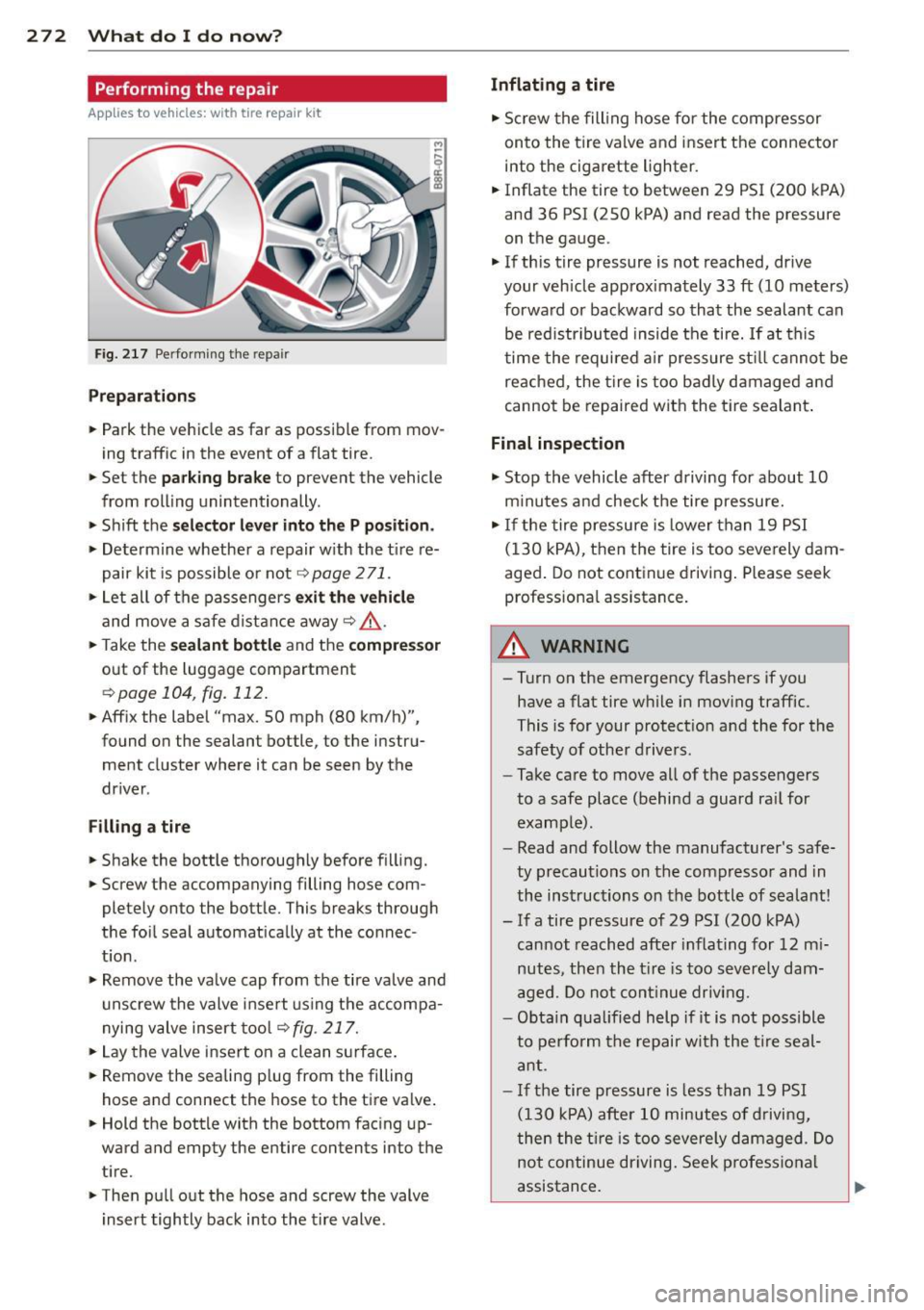
272 What do I do now ?
Performing the repair
App lies to vehicles: with tire repair kit
Fig. 217 Perform ing the rep air
Pre parati ons
.. Park the vehicle as far as possible from mov
ing traffic in the event of a flat tire.
.. Set the
parki ng brake to prevent the vehicle
from roll ing unintentionally .
.. Shift the
se lec tor le ver in to th e P po siti on.
.. Determine whethe r a repair w ith the tire re
pair kit is possible or not
¢ page 271.
.. Let all of the passengers ex it th e vehicle
and move a safe distance away ¢& .
.. Take the
sealant bottle and the compre ssor
out of the luggage compartment
¢ page 104, fig. 112.
.. Affix the label "max. 50 mph (80 km/h)",
found on the sealant bottle, to the instru
ment cluster where it can be seen by the
dr iver .
Fill ing a tire
.. Shake the bottle thoroughly before f il li ng.
.. Screw the accompanying filling hose com-
pletely onto the bottle. This breaks through
the foi l seal automatically at the connec
t ion.
.. Remove the valve cap from the tire va lve and
uns crew the valve inse rt using the accompa
nying valve insert too l¢
fig . 217.
.. Lay the valve insert on a clean s urface .
.. Remove the sealing p lug from the filling
hose and connect the hose to the tire va lve .
.. Hold the bottle with the bottom fac ing up
ward and empty the entire contents into the
tire.
.. Then pu ll out the hose and screw the valve
i nsert tightly back into the tire valve .
Inflating a tire
.. Screw the fill ing hose for the compressor
onto the tire valve and insert the connector
into the cigarette lighter .
.. Inflate the tire to between 29 PSI (200 kPA)
and 36 PSI (250 kPA) and read the pressure
on the gauge .
.. If this tire pressure is not reached, dr ive
your veh icle approximately 33 ft ( 10 meters)
forward or backward so that the sealant can be red istr ibuted inside the tire.
If at this
time the requi red a ir pressure st ill cannot be
reached , the tire is too badly damaged and
cannot be repaired with the tire sealant .
Final inspection
.. Stop the vehicle after driving for about 10
m inutes and check the tire pressure .
.. If the tire pressure is lower than 19 PSI
( 1 30 kPA), then the tire is too seve rely dam
aged. Do not continue driving . Please seek
professiona l assistance.
A WARNING
--
- Turn on the emergency flashers if you
have a flat tire while in moving traffic .
This is for your protect ion and the for the
safety of other drivers.
- Take care to move all of the passengers
to a safe place (behind a guard ra il for
example) .
- Read and follow the manufacturer's safe
ty precautions on the compressor and in
the instructions on the bottle of sealant!
- If a tire pressure of 29 PSI (200 kPA) cannot reached after inflating for 12 m i
nutes, then the t ire is too severe ly dam
aged. Do not cont inue driving.
- Obta in qualified help if it is not possible
to pe rform the repair w ith the tire seal
a nt .
- I f the tire pressure is less than 19 PSI
(130 kPA) afte r 10 minutes of d riving,
then the t ire is too severely damaged . Do
not continue dr iving. Seek p rofess ional
assistance .
Page 275 of 316
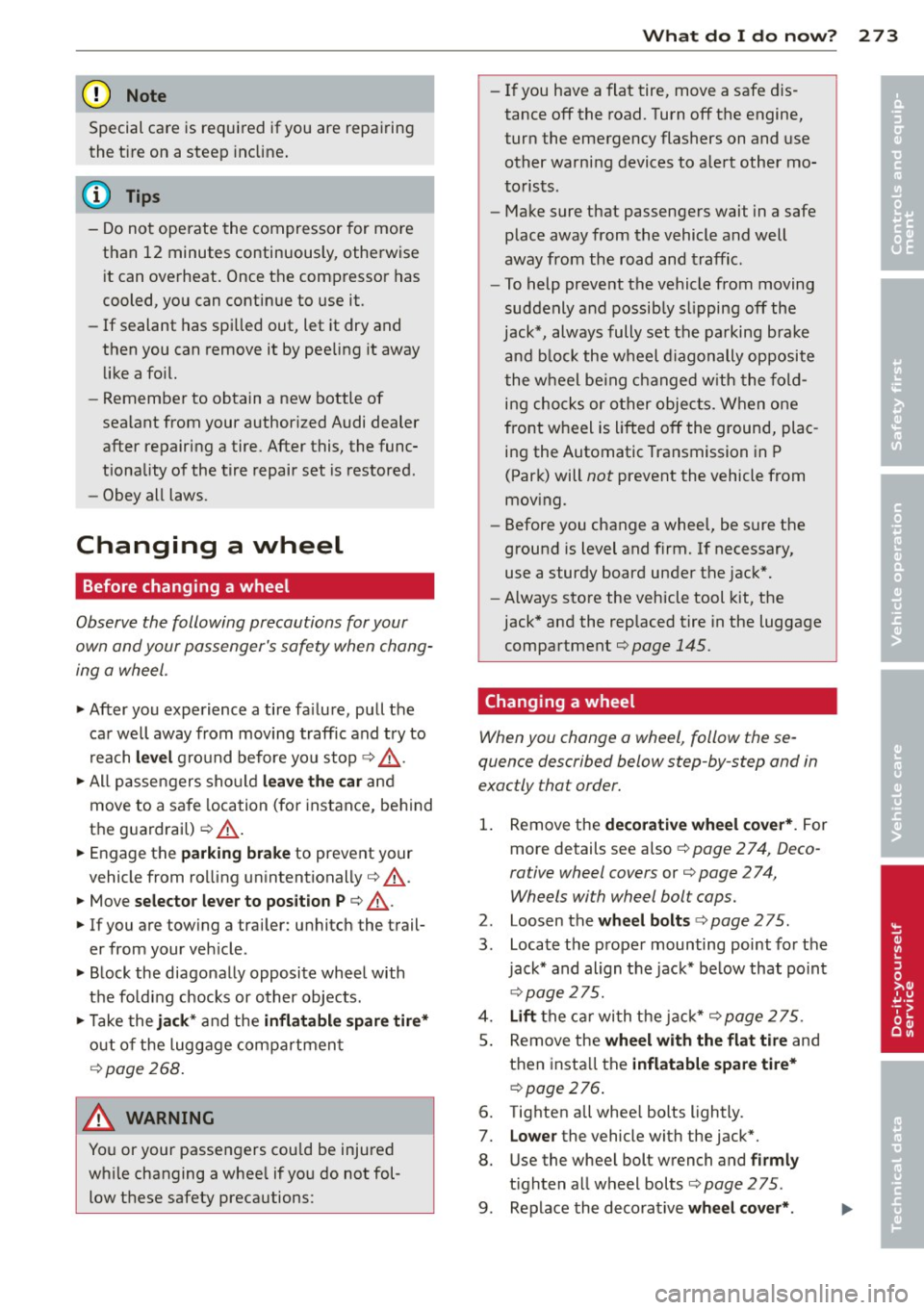
(D Note
Special care is required if you are repairing
the tire on a steep incline.
@ Tips
-Do not operate the compressor for more
than 12 minutes continuously, otherwise it can overheat. Once the compressor has
cooled, you can continue to use it.
- If sealant has spilled out, let it dry and
then you can remove it by peeling it away
like a foil.
- Remember to obtain a new bottle of
sealant from your authorized Audi dealer
after repairing a tire. After this, the func
tionality of the tire repair set is restored.
- Obey all laws.
Changing a wheel
Before changing a wheel
Observe the following precautions for your
own and your passenger's safety when chang
ing a wheel.
.,. After you experience a tire failure, pull the
car well away from moving traffic and try to
reach
level ground before you stop¢_& .
.. All passengers should
leave the car and
move to a safe location (for instance, behind
the guardrail) ¢
_&.
.. Engage the parking brake to prevent your
vehicle from rolling unintentionally¢_&.
.. Move
selector lever to position P ¢ _& .
.,. If you are tow ing a trai ler: unhitch the trail
er from your vehicle.
.,. Block the diagonally opposite wheel with
the folding chocks or other objects.
.. Take the
jack* and the inflatable spare tire*
out of the luggage compartment
¢page 268.
A WARNING
You or your passengers could be injured
while changing a wheel if you do not fol
low these safety precautions:
-
What do I do now? 273
- If you have a flat tire, move a safe dis
tance off the road. Turn off the engine,
turn the emergency flashers on and use
other warning devices to alert other mo
torists.
- Make sure that passengers wait in a safe
place away from the vehicle and well
away from the road and traffic.
- To help prevent the vehicle from moving
suddenly and possibly slipping off the
jack*, always fully set the parking brake
and block the wheel diagonally opposite
the wheel being changed with the fold
ing chocks or other objects. When one
front wheel is lifted off the ground, plac
ing the Automatic Transmission in P
(Park) will
not prevent the vehicle from
moving.
- Before you change a wheel, be sure the
ground is level and firm. If necessary,
use a sturdy board under the jack*.
- Always store the vehicle tool kit, the
jack* and the replaced tire in the luggage
compartment
¢page 145.
Changing a wheel
When you change a wheel, follow the se
quence described below step-by-step and in
exactly that order.
1. Remov e the decorative wheel cover*. For
more details see also
¢ page 274, Deco
rative wheel covers
or ¢ page 2 7 4,
Wheels with wheel bolt cops .
2. Loosen the wheel bolts¢ page 2 75 .
3. Locate the proper mounting point for the
jack* and align the jack* below that point
¢ page 275.
4. Lift the car with the jack* ¢ page 2 75 .
S. Remove the wheel with the flat tire and
then install the
inflatable spare tire*
¢page 276.
6. Tighten all wheel bolts lightly.
7.
Lower the vehicle with the jack*.
8. Use the wheel bolt wrench and
firmly
tighten all wheel bolts¢ page 2 75.
9. Replace the decorative wheel cover*.
•
•
Page 276 of 316
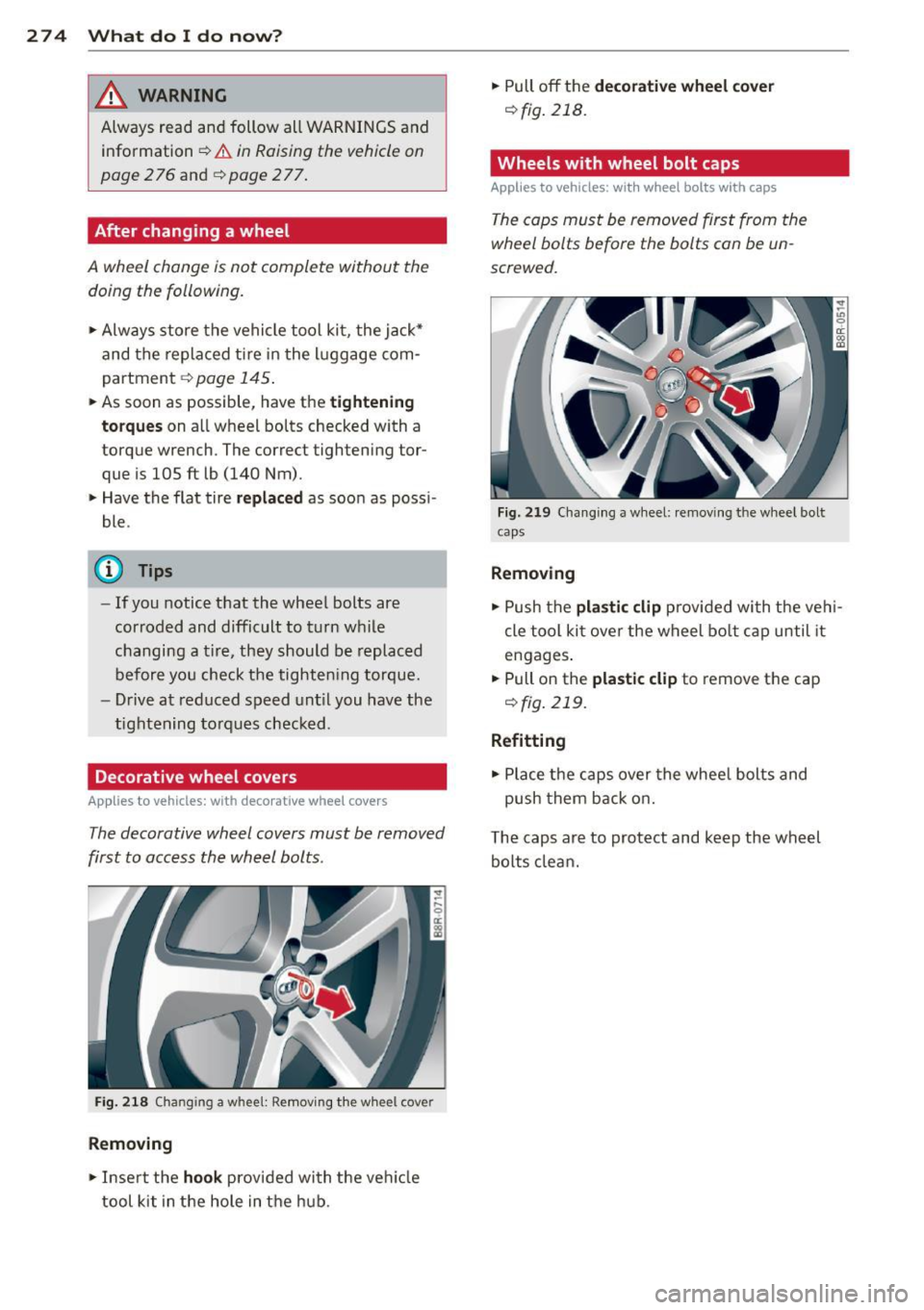
274 What do I do now ?
A WARNING
Always read and follow all WA RNINGS and
information
c::> & in Raising the vehicle on
page 276
and c::> page 277.
After changing a wheel
A wheel change is not complete without the
doing the following .
.,. Alw ays store t he vehicle too l ki t, the j ack*
and the replaced tire in t he l uggage com
partment
¢ page 145 .
.,. As soon as possible, have the tightening
to rques
on a ll wheel bo lts checked with a
torq ue wrench. The correct tighten ing tor
que is 105
ft lb (140 Nm) .
.,. Have the flat tire
replaced as soo n as poss i
ble.
(D Tips
- If you notice t hat the wheel bolts are
corroded and difficult to turn while
changing a t ire, they should b e replaced
b efore y ou check t he tighte ning tor que.
- Drive a t reduced speed unt il you have the
tightening to rques checked .
Decorative wheel covers
Applies to vehicles: with decorative wheel covers
The decorative wheel covers must be removed
first to access the wheel bolts .
Fig. 218 Changing a w heel: Remov ing the w heel cover
Removing
.,. Inse rt the hook prov ided wi th t he ve hicle
tool kit in the hole in t he hu b. .,.
Pull off the
decor ative wheel cover
c::> fig . 218.
Wheels with wheel bolt caps
Applies to vehicles: wit h wheel bolts with caps
The caps must be removed first from the
wheel bolts before the bolts can be un
screwed.
Fig. 219 C ha ngin g a w heel: re m ovi ng the whee l bo lt
caps
Removing
.,. Push the plasti c clip prov ided wi th the ve hi
cle tool ki t ove r the wheel bo lt c ap until it
engages .
.,. Pull on the
plastic clip to remove the cap
c::> fig . 219.
Refitting
.,. Place the caps over the whee l bolts and
push them back o n.
T he caps ar e to protect and keep the whe el
bolts clea n.
Page 277 of 316
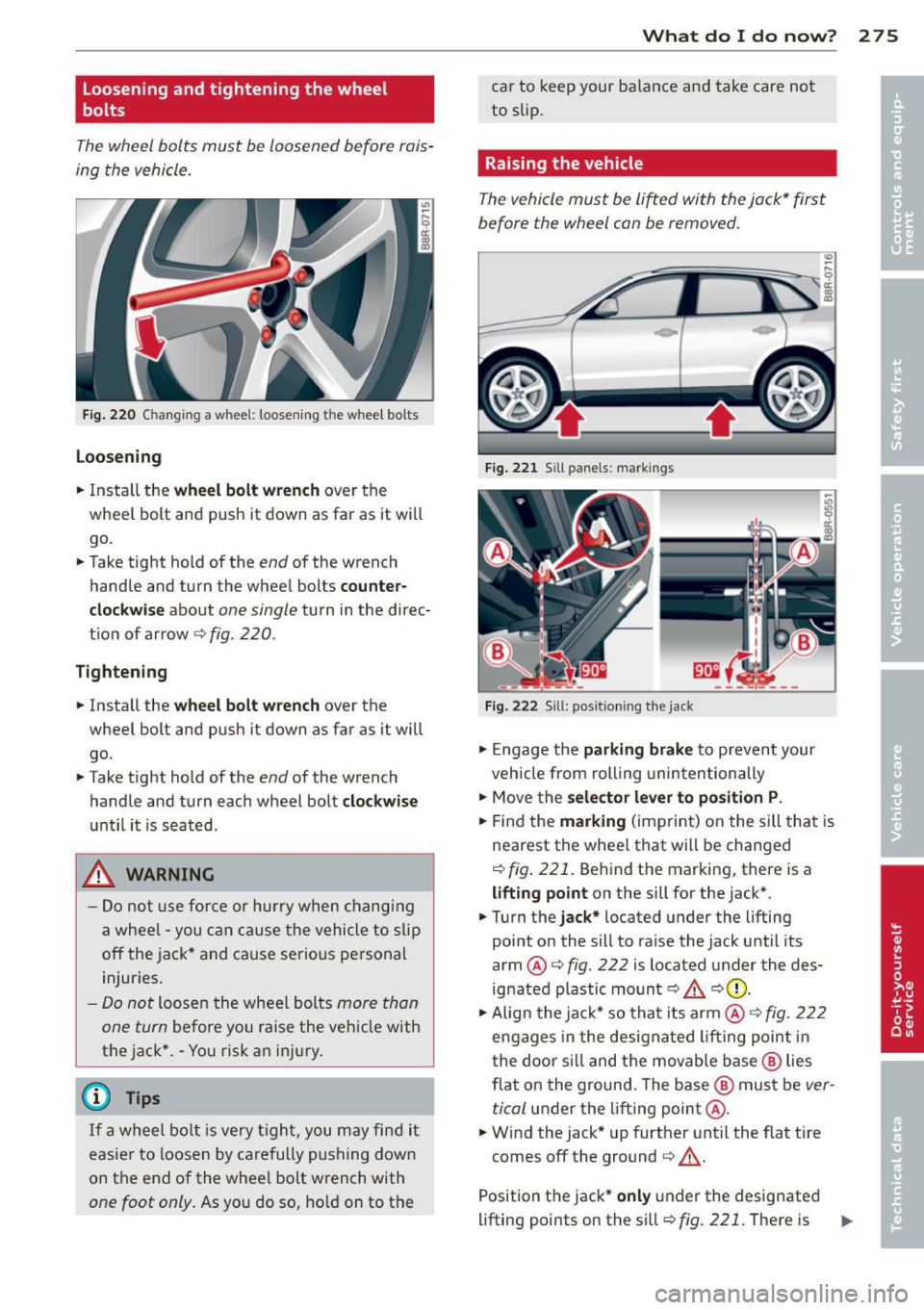
Loosening and tightening the wheel
bolt s
The wheel bolts must be loosened before rais
ing the vehicle.
Fig . 220 Changing a wheel: loosening the whee l bo lts
Loosening
.. Install the wheel bolt wrench over the
wheel bolt and push it down as far as it will
go .
.. Take tight hold of the
end of the wrench
handle and turn the wheel bolts
counter
clockwise
about one single turn in the direc
t ion of arrow c::>
fig. 220.
Tightening
.. Install the wheel bolt wrench over the
wheel bolt and push it down as far as it will go.
.. Take tight hold of the
end of the wrench
handle and turn each wheel bolt
clockwise
until it is seated .
.&, WARNING
-Do not use force or hurry when changing
a whee l -you can cause the vehicle to slip
off the jack* and cause serious personal
injuries.
- Do not loosen the wheel bolts more than
one turn
before you raise the veh icle with
the jack*. -You risk an injury .
(D Tips
If a wheel bolt is very tight, you may find it
easier to loosen by carefully pushing down
on the end of the whee l bolt wrench with
one foot only . As you do so, hold on to the
What do I do now? 275
car to keep your ba lance and take care not
to slip.
Raising the vehicle
The vehicle must be lifted with the jock* first
before the wheel con be removed.
Fig . 221 Sill panels : marking s
Fig. 222 Sill: positio ning the jack
.,. Engage the parking brake to prevent your
vehicle from rolling unintentionally
.. Move the
selector lever to position P .
.. Find the marking (imprint) on the s ill that is
nearest the whee l that will be changed
c::>fig . 221. Behind the marking, there is a
lifting point on the sill for the jack*.
.. Turn the
jack* located under the lifting
point on the sill to raise the jack until its
arm @c::>
fig. 222 is located under the des
ignated p lastic mount c::>
& c::>0.
.,. Align the jack* so that its arm@
c::> fig. 222
engages in the designated lifting point in
the door s ill and the movable base® lies
flat on the ground. The base@ must be
ver
tical
under the lifting point@.
.. Wind the jack* up further until the flat tire
comes off the ground
c::> & .
Position the jack* only under the designated
lifting points on the s ill
c::>fig. 221. There is ll-
Page 278 of 316
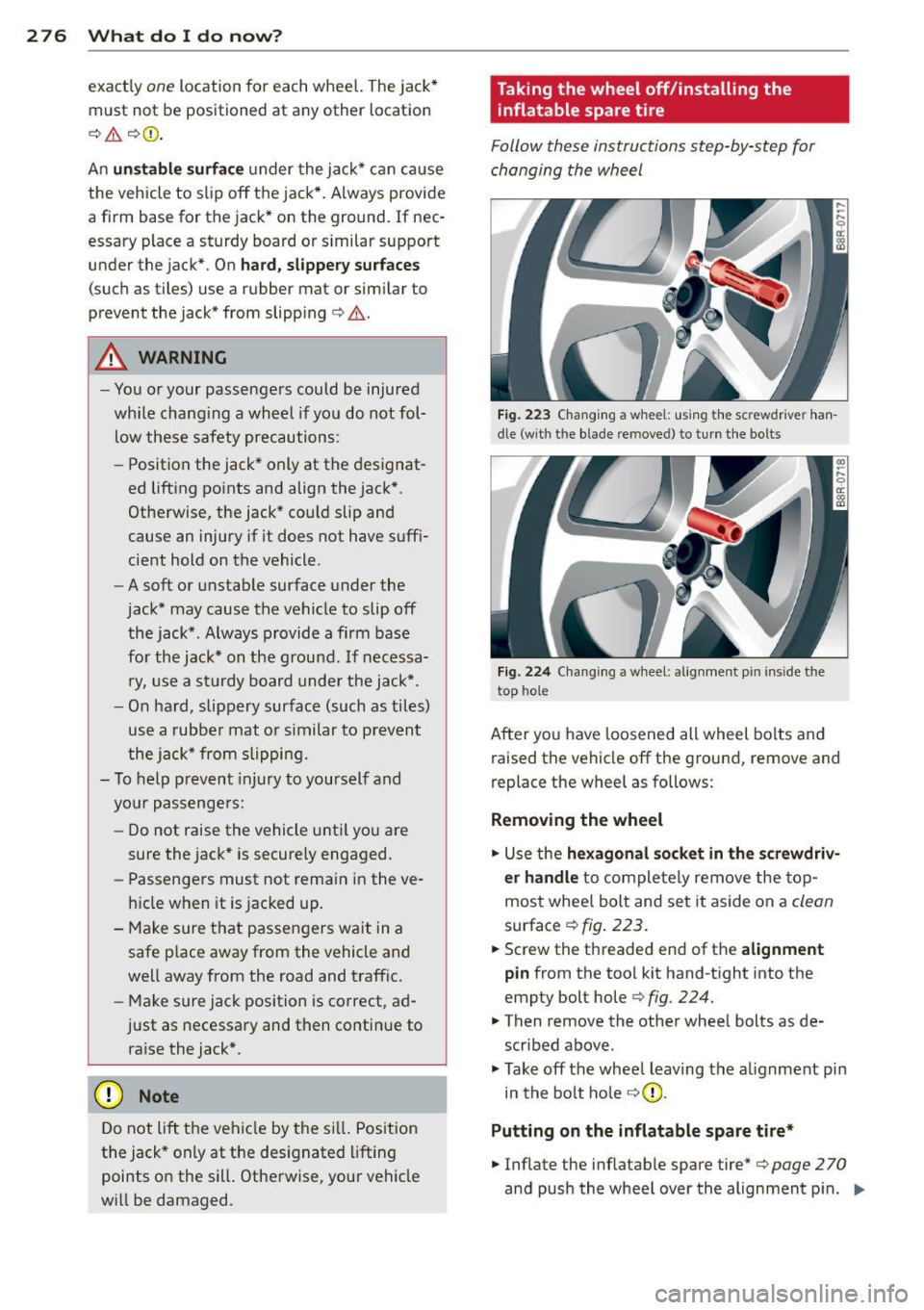
276 What do I do n ow ?
exact ly one location for each whee l. The jack*
must not be positioned at any other location
c::> &. c::> CD .
An un sta bl e s urfa ce under the jac k* can cause
the vehicle to slip off the jack* . Always provide
a firm base for the jack* on the ground. If nec
essary place a sturdy board or similar support
under the jack*. On
h ard , s lippe ry surfa ces
(such as tiles) use a rubber mat or sim ilar to
prevent the jack* from slipping
c::> &. .
_&. WARNING
-You or your passengers could be injured
wh ile chang ing a wheel if you do not fol
low these safety precautions:
- Position the jack * only at the designat
ed lifting points and align the jack *.
Otherwise, the jack* could slip and
cause an injury if it does not have suff i
cient hold on the vehicle.
- A soft or unstab le surface under the
jack* may cause the vehicle to slip off the jack*. Always provide a firm base
fo r the jack* on the ground . If necessa
r y, use a st urdy board under the jack*.
- On hard, slippery surface (such as tiles)
use a rubbe r mat o r similar to prevent
the jack* from slipping.
- To help p revent injury to yourself and
yo ur passenge rs:
- Do not raise the vehicle u ntil you are
sure the jack* is securely engaqed.
- Passengers must not remain in the ve
h icle when it is jac ked up .
- Make sure that passengers wait in a
safe p lace away from the vehicle and
well away from the road and traffic.
- Make sure jack position is correct, ad
just as necessary and then continue to
ra ise the jack *.
(D Note
Do not lift the vehi cle by the s ill. Position
the jack* only at the des ignated lifting
points o n the sill. Otherwise, your veh icle
wi ll be damaged.
Taking the wheel off /installing the
inflatable spare tire
Follow these instructions step-by-step for
changing the wheel
F ig . 2 23 Chang ing a w hee l: using th e screwdr ive r han
dle (w ith the blade removed) to turn th e bolts
Fig . 22 4 Cha ng in g a w hee l: alig nment p in ins ide the
top ho le
After yo u have loosened all wheel bo lts and
raised the vehicle off the ground, remove and
replace the wheel as follows:
Removing the wheel
.,. Use the hexagonal so cket in th e screwdriv
er handle
to complete ly remove the top
most whee l bolt and se t it aside on a
clean
surface c::> fig . 223 .
.,. Screw the threaded end of the alignment
pin
from the tool kit hand-t ight into the
empty bolt hole
c::> fig. 224.
.,. Then remove the other wheel bolts as de
scribed above.
.,. Take off the whee l leaving the a lignment pin
in the bo lt ho le
c::> (D .
Putting on the inflatable spare tire*
.,. Inflate the inflatab le spare tire* c::> page 2 70
and push the wheel over the alignment p in . "'
Page 279 of 316
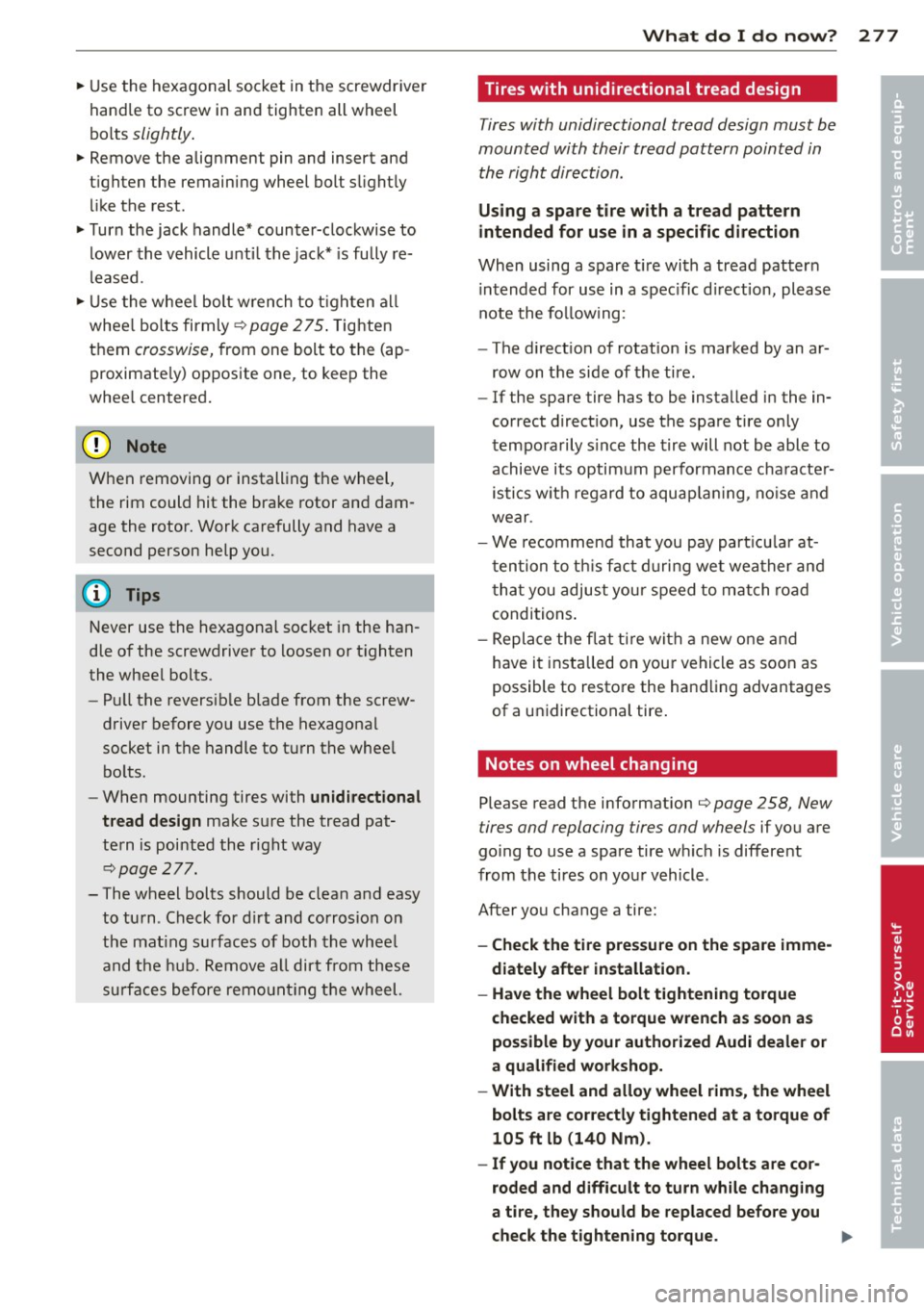
~ Use the hexagonal socket in the screwdriver
handle to screw in and tighten all wheel
bo lts
slightly .
~ Remove the alig nment pin and insert and
t igh ten the remaining wheel bolt s light ly
Like t he rest.
~ Turn th e jack handle* counter-clockwise to
l ower the vehicle unti l the jack* is fully re
leased .
~ Use the whee l bolt w rench to t ighten a ll
whee l bolts firmly <=>
page 2 75. Tighten
them
crosswise, from one bolt to the (ap
proximate ly) opposite one, to keep the
whee l centered.
Q;) Note
When removing or installing the wheel,
the rim could hit the brake rotor and dam
age the rotor. Work carefully and have a
second person help you.
(D} Tips
Never use the hexagonal socket in the han
dle of the screwdriver to loosen or tighten
the wheel bolts .
- Pull the reversib le b lade from the screw
driver before yo u use the hexagonal
socket in the handle to t urn the whee l
bo lts .
- When mounting tires with
unid irectional
tread design
make sure the tread pat
te rn is poi nted the right way
<=> page 2 77.
- The wheel bolts should be clea n and easy
to tu rn . Check for d irt and corrosion on
the mat ing s urfaces of both the wheel
and the hub. Remove a ll dirt from these
su rfaces before remo unting the wheel.
What do I do now? 277
Tires with unidirectional tread design
Tires with unidirectional tread design must be
mounted with their tread pattern pointed in the right direction .
Using a spa re tire with a tread pattern
intended for use in a specific direction
When using a spare t ire wi th a tread pat ter n
intended for use in a spec ific d irect ion, please
note the fo llowing :
- The d irect io n of rotation is marked by an ar
row on t he side of the ti re .
- If the spare tire has to be insta lled in the in
correct d irect ion, use the spare tire only
temporarily s ince the t ire will not be able to
achieve its optimum performance cha racte r
is tic s w it h regard to aquap la ni ng, no ise and
wear .
- We recommend that you pay part icu lar at
t en tion to th is f act d uring we t wea ther and
t ha t you adjus t you r speed to m atch r oad
conditions .
- Repla ce the fl at t ire wi th a new o ne and
have i t installed on your vehicle as soo n as
possible to resto re the han dling advantages
of a u nidirectional tire .
Notes on wheel changing
Please read the information¢ page 258, New
tires and replacing tires and wheels
if yo u a re
go ing to use a spare tire w hich is different
from the tires on yo ur vehicle .
After you change a tire:
- Check the tire pre ssure on the spare imme
diately after installation.
- Have the wheel bolt tightening torque
checked with a torque wrench as soon a s
possible by your authorized Audi dealer or
a qualified workshop.
- With steel and alloy wheel rims , the wheel
bolts are cor re ctly tightened at a torque of
105 ft lb (140 Nm).
- If you notice that the wheel bolts are cor
roded and diff icult to turn while changing
a tire, they should be replaced before you
check the t ightening torque. .,,.
•
•
Page 280 of 316
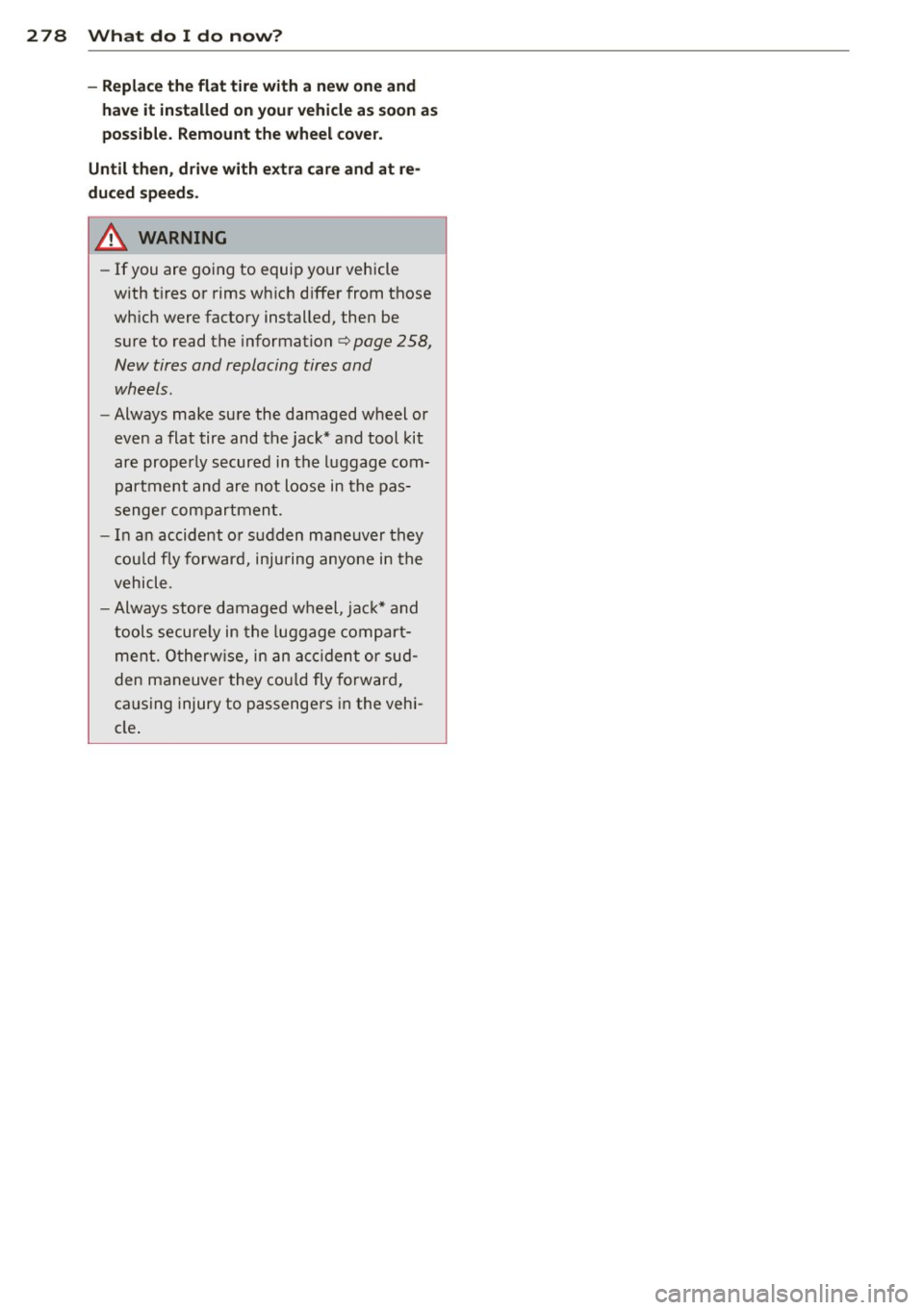
278 What do I do no w?
-Repl ace th e flat tire with a n ew one and
h av e it in sta ll ed on you r ve hicle a s soo n a s
possible. Remount the wheel co ve r.
Until then, drive with extr a ca re a nd at re
du ced spee ds.
A WARNING
-
- If you are going to equip your vehicle
with t ires or rims wh ich d iffer from those
wh ich were factory installed, then be
sure to read the informat ion
c::> page 258,
New tires and replacing tires and
wheels.
- Always make sure the damaged wheel or
even a flat tire and the jack* and tool kit
are properly secured in the luggage com
partment and are not loose in the pas
senger compartment.
- In an accident or sudden maneuver they
cou ld fly forward, inju ring anyone in the
vehicle.
- Always store damaged wheel, jac k* and
tools secure ly in the luggage compart
ment. Otherw i5e, in an acc ident or 5ud
den maneuver they cou ld fly forward,
causing injury to passengers in the vehi
cle .